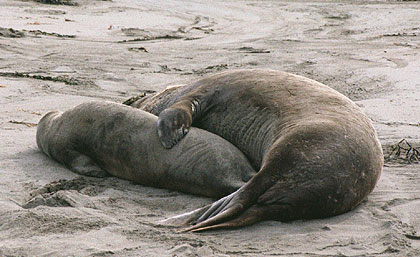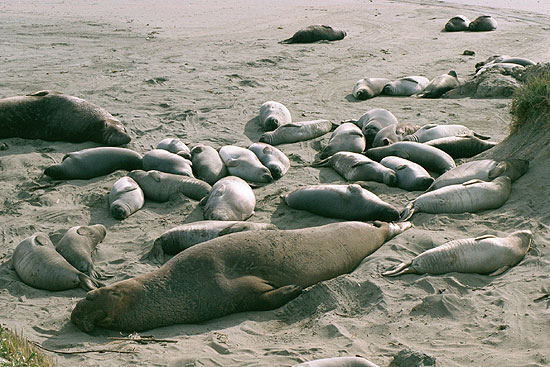 |
|
||||||||||||||||||
 Hunted nearly to extinction for their oil-rich blubber, elephant seals have made a remarkable comeback. Protected by the Marine Mammal Protection Act, they are expanding their range outward from remote islands and are now colonizing selected mainland beaches such as Piedras Blancas in the southern range of Big Sur, near San Simeon. Hunted nearly to extinction for their oil-rich blubber, elephant seals have made a remarkable comeback. Protected by the Marine Mammal Protection Act, they are expanding their range outward from remote islands and are now colonizing selected mainland beaches such as Piedras Blancas in the southern range of Big Sur, near San Simeon.Elephant seals come ashore and form colonies for only a few months of each year to give birth, breed, and molt. The rest of the year the colonies disperse and individuals spend most of their time in pursuit of food, a quest which involves swimming thousands of miles and diving to great depths. Aerial photo of Piedras Blancas Elephant Seal View Point
|
|
Elephant seals, Mirounga angustirostris, are true seals, or earless seals, members of the pinniped suborder. What marvelous creatures they are: huge blubbery males with the pendulous noses that give these beasts their name; winsome females whose faces seem to be etched with a permanent smile; and endearing plump babies with big appetites.
The breeding season begins in late November when mature bulls begin to arrive and fight to determine dominance. The females start arriving in the middle of December and continue to arrive until the middle of February. The first birth is around Christmas, but most births usually occur during the last two weeks of January. The females remain on the beach for about five weeks from the time they come ashore. Amazingly, the males are on the beach for up to 100 days. The seals are fasting while they are on land, and both males and females lose about 1/3 of their body weight during the breeding season.
The pups are usually born within 4-5 days of the female's arrival, and weigh between 60-80 pounds. They nurse for 24-28 days on the richest milk in the mammal world. Mating occurs during the last 3-5 days of nursing. The peak of mating activity is around Valentine's Day. Pups are weaned when the mother abruptly departs for sea. The weaned pups, dubbed "weaners," have quadrupled their birthweight and are nice and plump. They will lose about 1/3 of their weight during the "weaner fast," the 8-10 weeks they remain at the rookery, teaching themselves how to swim, before taking off on their first foraging trip. While elephant seals are at sea in search of food they dive to incredible depths. Typically they dive between 1000-2000 feet, but the record is over 5000 feet. The average length of dive is 20 minutes, but they can dive for an hour or longer. When they resurface they only spend 2-4 minutes before diving again - and they continue this diving pattern 24 hours a day. Male and female elephant seals are believed to feed on different prey. The female diet is primarily squid and the male diet is more varied, comprised of small sharks, rays and other bottom-dwelling fish. In their search for food the males travel along the continental shelf to the Gulf of Alaska. The females tend to head north and west into more open ocean. Elephant seal make this migration twice a year, also coming back to the rookery to Human beings shed hair and skin all the time, but elephant seals go through a catastrophic molt, in which the entire layer of epidermis with the hairs attached is sloughed off in one concentrated time. The reason for this abrupt molt is that while at sea they spend most of their time in cold deep water. As part of the dive process the blood is diverted away from the skin. This helps them conserve energy and avoid losing body heat. By coming up on land to molt the blood can be circulated to the skin so a new layer of epidermis and hair can be grown.
What is an elephant seal? A deep-sea diver, a long distance traveler, an animal that fasts for long periods of time, elephant seals are extraordinary. They come together on land to give birth, mate, and molt but at sea they are solitary. Tremendous demands are placed on their bodies. The more you learn about these animals the more you will say WOW! Text supplied by Friends of the Elephant Seals. For more information about the elephant seal colony history, a calendar of events, updated and current news on the colony, please visit their website and support their cause at www.elephantseal.org These elephant seals reside within the Monterey Bay National Marine Sanctuary which emcompasses 276 miles of shoreline and 5,322 square miles of ocean. Click Here for more information about MBNMS. ELEPHANT SEAL ANNUAL SCHEDULE: January Female elephant seals continue to arrive on the shoreline. Peak of births usually are the last half of the month. February Elephant seal births continue. The peak of mating is around Valentine's Day. More females leave. March Last adult elephant seals leave. April Female and juvenile elephant seals return to molt. May Female and juvenile elephant seals molt. June Sub-adult male elephant seal return to molt. July Sub-adult and adult males molt. August Last adult elephant seals molt. September Young-of-the-year and juvenile elephant seals haul out to rest. October Young-of-the-year and juvenile elephant seals haul out to rest. November Subadult elephant seal males haul out. Mature males begin arriving at the end of the month. December Elephant seal bulls continue to return. Females arrive. The first birth is usually mid-month. |
Big Sur Chamber of Commerce - http://www.bigsurcalifornia.org (831) 667-2100
